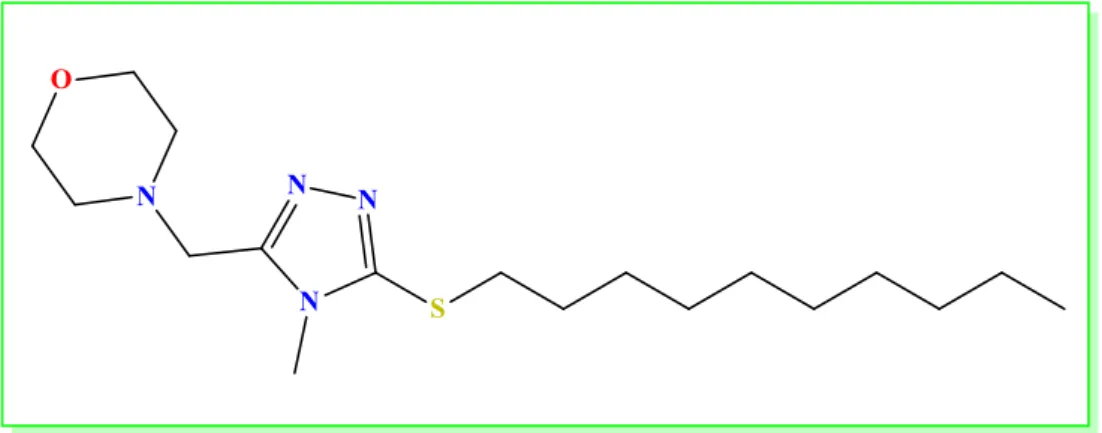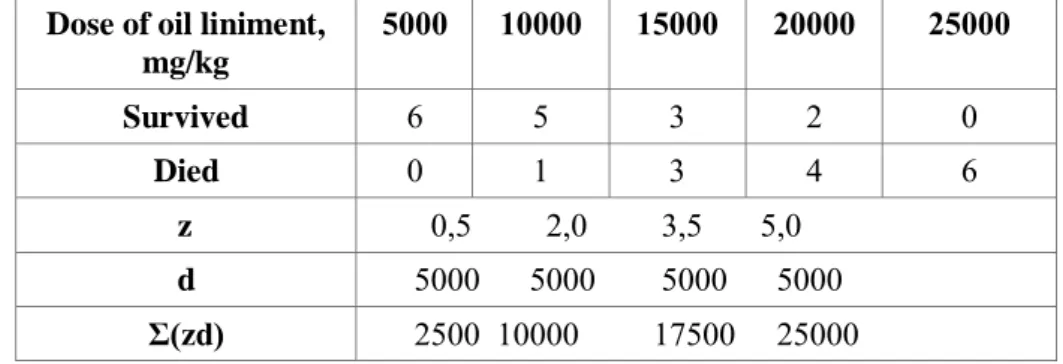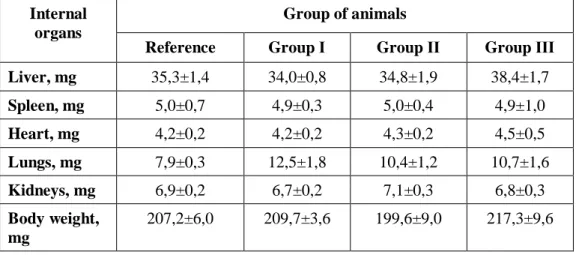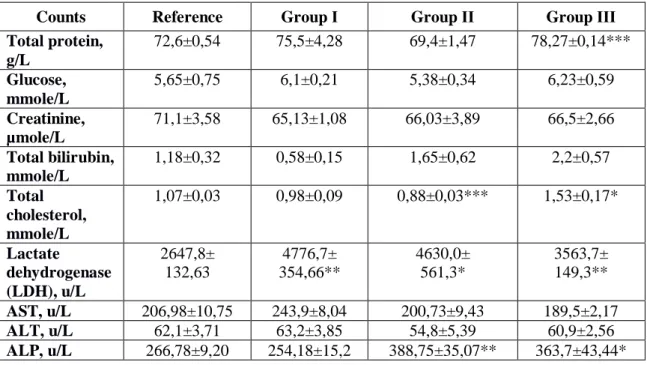EVALUATION OF ACUTE AND SUBACUTE TOXICITY OF OIL
LINIMENT BASED ON
4-((5-(DECYLTHIO)-4-METHYL-4H-1,2,4-TRIAZOL-3-YL)METHYL)MORPHOLINE
4-((5-(DESİLTİYO)-4-METİL-4H-1,2,4-TRİAZOL-3-İL)METİL)MORFOLİN ESASLI
YAĞ MERHEMİ AKUT VE SUBAKUT TOKSİSİTE PARAMETRELERİ TAYİNİ
Roman SHCHERBYNA1* , Volodymyr PARCHENKO1, Volodymyr MARTYNYSHYN2,Vasyl HUNCHAK2
1Zaporizhzhya State Medical University, Faculty of Pharmacy, Department of Toxicological and
Inorganic Chemistry, Zaporizhzhya, Ukraine
2Stepan Gzhytskyi National University of Veterinary Medicine and Biotechnologies, Faculty of
Veterinary Medicine, Department of Pharmacology and Toxicology, Lviv, Ukraine
ABSTRACT
Objective: It has now been demonstrated that compound
4-((5-(decylthio)-4-methyl-4H-1,2,4-triazol-3-yl)methyl)morpholine shows antifungal and antimicrobial activities. This study was aimed to estimate toxicity values of novel oil liniment, which is based on mentioned compound and has antifungal effect.
Material and Method: Research was held in accordance with guidelines “Toxicological screening
of new substances for animal safety products” and “Preclinical esearch of veterinary drugs”. Toxicity level (amount of toxic doses) and benchmark doses for subacute study were assessed in conditions of acute study. Experiments were conducted on male wistar rats using karber method.
Result and Discussion: Findings in the research of the acute effect have shown that studied substance
belongs to the group of low-toxic compounds in conditions of intragastric administration. All rats survived and completed subacute study, and daily administration of oil liniment in duration of 14 days did not cause possible changes in body and organ weight among animals in experimental groups. It was demonstrated that prolonged exposure to the liniment caused possible increase of ALP and LDH on the background of possible cholesterol decrease, which may be the evidence of cholestatic liver disease, and enhancement of permeability of the cell membranes, which may be highlighted by destructive changes in liver.
* Sorumlu Yazar /Corresponding Author: Roman Shcherbyna e-mail: rscherbyna@gmail.com
Keywords: 4-((5-(decylthio)-4-methyl-4H-1,2,4-triazol-3-yl)methyl)morpholine; rat; toxicity.
ÖZ
Amaç: 4-((5-(desiltiyo)-4-metil-4H-1,2,4-triazol-3-il)metil)morfolin maddesinin antifungal
ve antimikrobiyal özelliklere sahip olduğu gösterilmiştir. Bu araştırmanın amacı, bahsi geçen bileşen esaslı antifungal etkiye sahip yağ merhemi toksisitesini tespit etmektir.
Gereç ve Yöntem: Araştırma, ‘“Toxicological screening of new substances for animal
safety products” and “Preclinical research of veterinary drugs‘da yer alan yönergelere göre gerçekleştirilmiştir. Akut çalışma koşullarında toksisite düzeyi (toksik doz miktarı) ve subakut çalışma için kıyaslama dozları değerlendirilmiştir. Araştırmalar, Wistar sıçanları üzerinde karber yöntemi ile gerçekleştirilmiştir.
Sonuç ve Tartışma: Akut etkinin araştırılmasında bulgular, çalışılan maddenin intragastrik
uygulama koşullarında düşük toksik bileşikler grubuna ait olduğunu göstermiştir. Subakut çalışmalar tamamlandı ve tüm sıçanlar sağ kurtuldu. 14 gün boyunca günlük olarak yağ liniment uygulaması deney grupları içindeki hayvanlar ve organ ağırlığı arasında olası değişikliklere neden olmadı. Çalışma merheme uzun süreli maruz kalmanın, kolesterol düzeyinin azalmasına neden olabilecek ALP ve LDH'nin artışına neden olduğu ve karaciğerde yıkıcı değişikliklere sebep olabilecek hücre zarlarının geçirgenliğinin artışına sebep olabileceğini göstermiştir.
Anahtar kelimeler: 4-((5-(desiltiyo)-4-metil-4H-1,2,4-triazol-3-il)metil)morfolin; toksisite; sıçan
INTRODUCTION
In last decades chemistry of triazole compounds has been greatly developed and is well studied [1-3].Many of the medications, which contain compounds with 1,2,4-triazole ring, were discovered and applied in practice [3-6]. In that way, pharmaceuticals like vorazole [7] and anastrozole [6] demonstrate antitumor activity, trazodone, alprazolam show antidepressant effects [4, 8]. Drug substances based on itraconazole, fluconazole, voriconazole, posaconazole, albaconazole, ravuconazole, isavuconazole, efinaconazole have been introduced into medical practice due to their antifungal activity [1].
In our previous studies, it was demonstrated that 4-R-5-R1-1,2,4-triazole-3-thiol derivatives
exhibit wide spectrum of pharmacological [9-11] and biological activities [12-14]. Thus, one of alkyl derivatives of 4-R-5-(morpholinomethylene)-4H-1,2,4-triazole-3-thiols, compound 4-((5-(decylthio)-4-methyl-4H-1,2,4-triazol-3-yl) methyl) morpholine shows antifungal and antimicrobial effects. In so doing, taking into account previous results, the aim of this work was to estimate toxicity of oil liniment, which contains 4-((5-(decylthio)-4-methyl-4H-1,2,4-triazol-3-yl)methyl)morpholine [15] using laboratory animals in conditions of single administration (“acute toxicity”) and prolonged exposure (“subacute toxicity”).
MATERIAL AND METHOD
The object of the study was a liniment prepared in a form of oily solution of 4-((5-(decylthio)-4-methyl-4H-1,2,4-triazol-3-yl) methyl) morpholine (Figure 1) using conventional technique with load of solvent in order of ascending viscosity or density [15].
Toxicity level (amount of toxic doses) and benchmark doses for subacute study were assessed in conditions of acute study. Experiments were conducted on male Wistar ratsusing Karber method. Research was held in accordance with guidelines “Toxicological screening of new substances for animal safety products” [16] and “Preclinical research of veterinary drugs” [17].
Figure 1. The structure of 4-((5-(decylthio)-4-methyl-4H-1,2,4-triazol-3-yl) methyl) morpholine
Animal ethics
The study was approved by the Committee on Animal Use and Ethical Review, Stepan Gzhytskyi National University of Veterinary Medicine and Biotechnology Lviv according to policy of European Convention for the protection of vertebrate animals (Protocol №5, 26 October 2016).
The study of acute toxicity
Parameters estimated in conditions of acute experiment were: a) toxic level (amount of toxic doses); b) benchmark doses for subacute study.
Acute toxicity has been investigated performing intragastric administration of oil liniment on rats, which were 2-3 months of age and weighed 190-200 g. For this purpose, in preliminary study animals were divided into three groups following the principle of analogues. Oil liniment was administrated to each group in doses of 5000, 10000 and 25000 mg/kg respectively. In a detailed study, animals were divided into six groups of six animals in each group. Substance was administrated to animals in group I in dose of 5000 mg/kg, group II – 10000 mg/kg, group III –
15000 mg/kg, group IV – 20000 mg/kg, group V – 25000 mg/kg of body weight. LD50 was
determined using Karber method.
After administration of oil liniment, animals were further monitored during 14 days. In the experiment, the following markers were taken into account: appearance, behavior of animals, hair condition and state of visible mucous membranes, appetite, respiration rhythm and rate, time of onset and profile of intoxication, its severity, course, time of animals’ death or their recovery [18].
The study of subacute toxicity of oil liniment
During the study of subacute toxicity, team relied upon the results obtained in the study of acute toxicity. Substance of research was administrated intragastrically on daily basis during 14 days. Subacute toxicity was studied on rats of 2-3 months of age and with body weight of 190-210 g. In the experiment, animals were divided into three groups in accordance with the principle of analogues; each group had five rats. Water was administrated to animals in the reference group. Animals in group I received oil liniment in amount of 1/50 LD50, group II – 1/20 LD50, group III –
1/10 LD50. Clinical condition and animals’ behavior were monitored during the study.
On the next day after administration was ceased, brief ether anesthesia was applied and animals were decapitated, team collected blood samples, studied hematology and biochemistry following generally accepted procedures, and applied necropsy to evaluate organ weight indexes, comparing results with the reference group.
For hematologic studies, blood samples stabilized with EDTA were used, for biochemical studies – the blood serum. The following blood counts were investigated: amount of hemoglobin, red cells, white cells, hematocrit; values of mentioned counts were obtained using hematology analyzer Mythic-18. Levels, which were assessed in blood serum samples: total protein using IRF-22 refractometer, enzyme activity (AST, ALT, LDH), total bilirubin, creatinine, and urine using biochemical analyzer HumaLyzer 3000 coupled with Human standard kit [16-19].
Obtained results were processed statistically; averages and confidence intervals were evaluated with significance level of р>0.05 and considering Student’s t-test.
RESULTS AND DISCUSSION
Results for the study of acute toxicity
The results for the study of acute toxicity are shown in Table 1.
Table 1. Values of acute toxicity of oil liniment applied on rats using intragastric administration. Dose of oil liniment,
mg/kg 5000 10000 15000 20000 25000 Survived 6 5 3 2 0 Died 0 1 3 4 6 z 0,5 2,0 3,5 5,0 d 5000 5000 5000 5000 Σ(zd) 2500 10000 17500 25000 LD50 was obtained using expression:
LD50= LD100 – Σ (z d)/ m,
here: LD100 – a dose, which caused death to all animals;
Σ – the sum symbol;
z – a half of all animals, which died from two next doses; d – difference between two next doses;
m – number of animals in each group per amount of dose Applying the expression, LD50 of oil liniment was:
LD50 = 25000 - [(2500+10000+17500+25000) : 6] = 15833,2 mg/kg
Hence, according to toxicity classification, in accordance with UCS 85.2-37-736:2011, the substance of research belongs to IV Toxicity Class, or practically non-toxic substances, if administrated intragastrically [18].
Results for the study of subacute toxicity of oil liniment
During the study of subacute toxicity none of laboratory rats had died. Table 2 contains evaluated organ weight indexes.
Table 2. Rats’ organ weight indexes evaluated on 15-th day of the subacute study (M±m, n=5)
Internal organs
Group of animals
Reference Group І Group ІІ Group ІІІ
Liver, mg 35,3±1,4 34,0±0,8 34,8±1,9 38,4±1,7 Spleen, mg 5,0±0,7 4,9±0,3 5,0±0,4 4,9±1,0 Heart, mg 4,2±0,2 4,2±0,2 4,3±0,2 4,5±0,5 Lungs, mg 7,9±0,3 12,5±1,8 10,4±1,2 10,7±1,6 Kidneys, mg 6,9±0,2 6,7±0,2 7,1±0,3 6,8±0,3 Body weight, mg 207,2±6,0 209,7±3,6 199,6±9,0 217,3±9,6
The results obtained after hematologic tests are shown in Table 3.
Table 3. Hematologic blood parameters of rats evaluated on 15-th day of the subacute study of the oil liniment (M±m, n=5)
Counts Reference Group І Group ІІ Group ІІІ
Hemoglobin, g/L 140,3±4,57 145,6±2,81 152,9±4,83 153,1±2,47 Red cells, Т/L 6,0±0,13 6,35±0,09 6,6±0,23 6,76±0,48 White cells, g/L 11,75±1,58 10,78±0,29 10,63±0,87 10,3±1,37 Hematocrit, % 37,3±1,37 38,55±0,97 40,05±1,31 40,7±0,96 Leukogram Neutrophils 22,0±3,37 21,0±1,91 21,0±1,91 24,0±2,31 Lymphocytes 69,5±3,40 71,0±3,51 69,0±1,29 64,7±3,71 Monocytes 6,5±0,5 6,5±0,96 8,0±0,82 7,33±0,67 Eosinophils 4,0±0,0 3,0±1,0 2,67±0,67 4,0±2,0 МСН, pg 23,4±0,66 22,9±0,67 23,2±0,37 22,8±1,24 МСНС, g/dL 37,7±0,19 37,7±0,29 38,15±0,30 37,6±0,47 МСV, µm3 62,1±1,86 60,75±2,06 60,65±0,48 60,66±2,69
The results obtained after biochemical tests are shown in Table 4.
Table 4. Biochemical blood parameters of rats evaluated on 15-th day of the subacute study of the oil liniment (M±m, n=5)
Counts Reference Group І Group ІІ Group ІІІ
Total protein, g/L 72,6±0,54 75,5±4,28 69,4±1,47 78,27±0,14*** Glucose, mmole/L 5,65±0,75 6,1±0,21 5,38±0,34 6,23±0,59 Creatinine, µmole/L 71,1±3,58 65,13±1,08 66,03±3,89 66,5±2,66 Total bilirubin, mmole/L 1,18±0,32 0,58±0,15 1,65±0,62 2,2±0,57 Total cholesterol, mmole/L 1,07±0,03 0,98±0,09 0,88±0,03*** 1,53±0,17* Lactate dehydrogenase (LDH), u/L 2647,8± 132,63 4776,7± 354,66** 4630,0± 561,3* 3563,7± 149,3** AST, u/L 206,98±10,75 243,9±8,04 200,73±9,43 189,5±2,17 ALT, u/L 62,1±3,71 63,2±3,85 54,8±5,39 60,9±2,56 ALP, u/L 266,78±9,20 254,18±15,2 388,75±35,07** 363,7±43,44* Note: * - р<0,05, ** - р<0,01,*** - р<0,001
Results in Table 2 show that intragastric administration of oil liniment during 14 days did not cause possible changes in body weight and weight indexes of liver, spleen, heart and lungs of animals in groups I, II and III.
Hematologic tests determined that administration of oil liniment to animals in groups I, II and III did not cause significant changes in hemoglobin amounts, counts of red cells, white cells, hematocrit, levels of mean corpuscular hemoglobin (MCH), mean corpuscular hemoglobin concentration (MCHC), mean corpuscular volume (MCV) (Table 3).
Test for morphological composition of white cells in peripheral blood showed, that after rats in groups I, II and III received oil liniment absolute lymphocyte, monocyte, and neutrophil counts did not change significantly and were comparable to values obtained for the reference group (Table 3).
Results in Table 4 contain data obtained during biochemical tests, which highlight that total protein in animals in groups I and II did not change significantly, while amount of this value was increased by 7,8 % (р<0,001) in animals in group III, in relation to the reference group.
this value was possibly down by 17,8 % (р<0,001) in animals in group II, while the same value was possibly up by 42,9 % (р<0,05) in animals in group III, in relation to measured levels in reference group (lipid storage disorder) (Table 4).
Assessment of LDH activity in blood serum after administration of oil liniment showed that amount of LDH raised by 80 (р<0,01), 74,9 (р<0,05) and 34,6 % (р<0,01) in groups I, II and III respectively, in relation to the reference group.
Assessment of ALP activity in conditions of prolonged exposure showed no significant changes of this value among animals in group I, although possible increase of ALP levels was seen in animals of group II and III by 45,7 (р<0,01) and 36,3 % (р<0,05) respectively, in relation to the reference group.
Moreover, it is worth noting that during administration of oil liniment to animals in groups I, II and III levels of creatinine, urine, glucose, total bilirubin, activities of AST and ALT did not differ significantly, compared to values in the reference group.
Autopsy of animals in group I revealed small flatulence, and presence of liquid fecal matter in a bowel. During autopsy of animals in groups II and III flatulence, and liquid yellow colored fecal matter with air bubbles and sharp odor were observed. Liver of animals in all groups was colored dark-red in some spots.
Interpreting obtained data, it must be underlined that prolonged exposure of oil liniment caused liver disease in animals, which was highlighted by cholestasia (increase of ALP) on the background of permeability enhancement of cell membranes, which may be evidenced by destructive changes in liver (increase of LDH activity in blood serum).
CONCLUSION
This work has revealed that oil liniment formulation of 4-((5-(decylthio)-4-methyl-4H-1,2,4-triazol-3-yl)methyl)morpholine belongs to Toxicity Class IV, i. e. practically non-toxic substances. It was demonstrated, that prolonged exposure of oil liniment caused possible increase of ALP and LDH in the background of possible decrease of total cholesterol, which may indicate on cholestatic liver disease, and increase of membrane permeability, which may be evidenced by destructive changes in liver.
REFERENCES
1. Peyton, L.R., Gallagher, S., Hashemzadeh, M. (2015). Triazole antifungals: a review. Drugs Today (Barc), 51(12), 705-718.
2. Gumber, K., Sidhu, A., Kaur, R. (2017). Sonochemical synthesis of novel magnesium 1, 2, 4-triazole-1-carbodithioate nanoparticles as antifungals. Applied Nanoscience, 7(3-4), 95-100. 3. Lin, L., Liu, H., Wang, D.J., Hu, Y.J., Wei, X.H. (2017). Synthesis and biological activities of
3, 6-disubstituted-1, 2, 4-triazolo-1, 3, 4-thiadiazole derivatives. Bulletin of the Chemical Society of Ethiopia, 31(3), 481-489.
4. Charney, D.S., Woods, S.W., Goodman, W.K., Rifkin, B., Kinch, M., Aiken, B., Heninger, G.R. (1986). Drug treatment of panic disorder: the comparative efficacy of imipramine, alprazolam, and trazodone. The Journal of clinical psychiatry, 47(12), 580.
5. Bushueva, I., Parchenko, V., Shcherbyna, R., Safonov, A., Kaplaushenko, A., Gutyj, B., Hariv, I. (2017). Tryfuzol-new original veterinary drug. J. Fac. Pharm. Ankara/Ankara Ecz. Fak. Derg, 41(1), 42-49.
6. Baum, M., Budzar, A.U., Cuzick, J., Forbes, J., Houghton, J.H., Klijn, J.G., Sahmoud, T. (2002). Anastrozole alone or in combination with tamoxifen versus tamoxifen alone for adjuvant treatment of postmenopausal women with early breast cancer: first results of the ATAC randomised trial. Lancet (London, England), 359(9324), 2131-2139.
7. Jakič, M., Vogler, A., Rižner, T.L. (2016). Pharmacological treatment of endometriosis: review of current and new options for treatment. Slovenian Medical Journal, 85(7-8), 410-426. 8. Jarema, M., Dudek, D., Landowski, J., Heitzman, J., Rabe-Jabłońska, J., Rybakowski, J. (2011).
Trazodon -the antidepressant: mechanism of action and its position in the treatment of depression. Psychiatria polska, 45(4), 611-625.
9. Shcherbyna, R.О., Panasenko, O.I., Knysh, Y.G., Fotina, H.A., Vashchyk, Y.V., Fotina, T.I. (2016). The study of antimicrobial activity of 2-((R-3-(morpholinomethylene)-4H-1, 2, 4-triazole-5-yl) thio) acetic acid salts. Zaporozhye medical journal, (4), 97-100.
10. Shcherbyna, R.O., Samura, T.O., Kyrychko, B.P., Zvenihorodska, T.V., Hyrenko, I.V. (2017). The research of ammonium 2-((4-amino-5-(morpholinomethyl)-4H-1, 2, 4-triazole-3-yl) thio) acetate (PKR-177) influence on biochemical indices in rats blood under hepatitis initiated by tetrachloride methane. Zaporozhye medical journal, 19(6), 819-822.
11. Shcherbyna, R.O., Parchenko, V.V., Safonov, A.A., Bushueva, I.V., Zazharskiy, V.V., Davydenko, P.O., Borovic, I.V. (2018). Synthesis and research of the impact of new derivatives
of 4-R-3 (morpholinomethyl)-4H-1, 2, 4-triazole-5-thiol on cultural attributes of pathogenic M. Bovis. Research journal of pharmaceutical biological and chemical sciences, 9(2), 70-79. 12. Shcherbyna, R.O., Danilchenko, D.M., Parchenko, V.V., Panasenko, O.I., Knysh, E.H.,
Hromyh, N.A., Lyholat, Y.V. (2017). Studying of 2-((5-R-4-R-1-4H-1, 2, 4-triazole-3-Yl) Thio) acetic acid salts influence on growth and progress of blackberries (KIOWA Variety) propagules. Research journal of pharmaceutical biological and chemical sciences, 8(3), 975-979.
13. Bihdan, O.A., Parchenko, V.V., Shcherbyna, R.O., Safonov, A.A. (2018). 1, 2, 4-Triazole Derivatives with Halogen Substituted Fragments, Their Synthesis, Modification and Biological Properties. Research journal of pharmaceutical biological and chemical sciences, 9(1), 22-29. 14. Shcherbyna, R.O. (2016) The synthesis and prediction of biological activity in silico for new
alkyl derivatives of 4-R-3-(morfolinometylen)-4H-1,2,4-triazole-5-thioles. Ukraïns’ kij bìofarmacevtičnij žurnal, 44, 34-38.
15. Martynyshyn, V.P., Gunchak, V.M., Gutyj, B.V., Hlukh, O.S. (2017). To the method of preparation of the liniment on the basis of thiopropyl triazole and his assessment of physical properties and performance on individual microorganisms and fungi. Scientific Messenger of LNU of Veterinary Medicine and Biotechnologies, 19(82), 36-40.
16. Kosenko, M.V., Malik, O.G., Kotsiumbas, I.Ya., Paterega, I.P., Chura, D.O. (1997) Toxicological control of new animal protection means: Methodical recommendations, Kiev, p.34.
17. Kotsiumbas, I.Ya,, Malik, O.G., Paterega, I.P., Tishin, O.L., Kosenko, Yu.M. (2006) Preclinical studies of veterinary medicines, Triad plus, Lviv, p.360.
18. Veterinary drugs. Determination of Acute Toxicity (2011). Standard of organization of Ukraine №85.2-37-736:2011. Ministry of Agrarian Policy, Kiev, p.16.
19. Stefanov, O.V., Litvinova, N.V., Filonenko-Patrusheva, M.A., Frantsuzova, S.B., Khrapak, V.V. (2001) Preclinical research of medicinal products: Methodical recommendations, Avicenna, Kiev, p.528.



